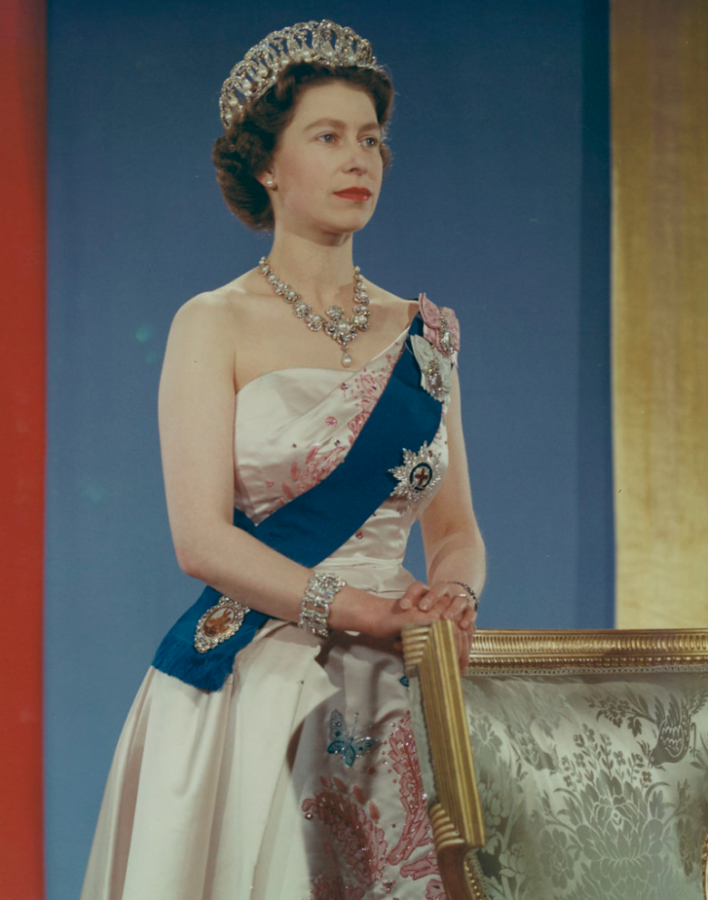Why it’s imperative for Americans to reflect on Queen Elizabeth II’s life
October 2, 2022
September 8, 2022, will forever be remembered as the day tragedy struck the United Kingdom, and echoed throughout the rest of the world. It was announced that day at 16:30 BST, that after 96 years of life Queen Elizabeth II had died. Due likely to natural causes, she passed away at Balmoral Castle in Scotland. Her Majesty had the longest reign in the history of British monarchs, acting for over 70 years as the country’s beloved queen. Her death elicited a global outpouring of grief. While this event will undoubtedly have an extensive impact on the English monarchy, it also has the ability to affect the way that Americans view power, publicity, and the precedent set by early feminist icons.
While some may consider the monarchy to be outdated or ineffectual, what must be recognized is that it is the expectation for a 21st century constitutional monarch to reign, but not rule. As the head of state, Queen Elizabeth II was never allowed to explicitly state her political beliefs to the public, but had the prerogative power to appoint new prime ministers and meet with them regularly to discuss parliamentary matters. It was also her duty to open each new session of parliament, grant royal assent to legislation, and approve orders and proclamations through the Privy Council. Throughout her entire reign, the queen worked with over fourteen different prime ministers, from Churchill, to Thatcher, to Truss. What can be learned from Elizabeth’s political career is that how one uses their power is infinitely more important than how much of it they have. She imbued ideals of tradition, and the importance of being a part of something bigger than oneself. Her being the leader and head of the Church of England was just as important as being the head of state.
Due to the public indifference she held concerning politics, the queen became a symbol of unity among British citizens despite their party affiliation. This allowed her to address issues of social justice and gender equality, in a detached and reserved manner. She sets a key example of how people should separate issues concerning human rights, from issues of politics.
When it comes to feminism, Queen Elizabeth II’s reign upheld the perfect juxtaposition of tradition and change. While some may argue that she was far from a feminist, the actions that she took as queen were striking for her time, and a great step in solidifying the position of women in power. In her role, she easily could have chosen to allow Prince Phillip to have a larger role in the monarchy by making him king consort, yet did not. She chose to remain the sole female head of state when it was expected for most women in her country to be housewives. She most definitely can be considered the head of her family as the “working mom” type, often leaving her children at home with their father while she was away on business trips.
Despite the political neutrality the queen held, her influence was undeniable. When she conferred her ceremonial approval of the Crown Act of 2013, she offset years of tradition that devalued the role of women in the British monarchy. It is commonly believed that this legislation may have failed without strong support from the queen. This is quite a significant advancement for the country, as it ended centuries of English history of the eldest son of a monarch being heir to the throne even if he had an older sister. It also allowed for English monarchs to marry those of the Roman Catholic faith. Though the queen perhaps had a personal interest in seeing the rule change, she proved throughout her reign that a woman could be a very effective monarch. Queen Elizabeth II never shied away from modernizing the monarchy when the opportunity arose, and this shift was a huge step forward for gender equality.
With Britain’s great and traditionalistic history of female leaders such as Queen Victoria, Queen Elizabeth I, and now the country’s third female prime minister, Liz Truss, it is hoped that other countries will follow suit in electing women into their primary political positions.
Another aspect of Queen Elizabeth II’s life that manages to combat traditional gender norms was her participation in the second world war. Young Elizabeth hoped to enlist as soon as she came of age, but the royal family refused to put her in danger, as she was the heir to the throne. Despite this, Elizabeth persisted. In 1945, when she turned eighteen, Elizabeth was given permission to join Women’s Auxiliary Territory Service. She worked and trained for six weeks as an auto mechanic. This wasn’t the average combat role, but was still a risky position to put a royal in. Hundreds of members of the Auxiliary Territory Service ended up dying throughout course of the war. Her dedication to her country and her willingness to serve just like any other English citizen made her extremely popular.
Queen Elizabeth II also managed to represent the kingdom well when it came to publicity and the larger media. Realizing that her subjects needed to see the royal family as approachable, she appeared on television regularly and spoke directly to her people. She also embraced new technology, sending out the first royal tweet in 2014. Additionally, she was the first monarch to record her annual Christmas message on film. So in many ways she is truly the first modern ruler. She had the first televised Christmas broadcast, and the first televised coronation. In 1969, a documentary was released in which she revealed to the public how her royal family truly interacted.
The filmmakers had access to the private family life of the queen, and produced an infamous two-hour film called “The Royal Family.” The documentary was part of an effort to humanize the royal family and alter their rigid image, and it was in many ways an incredible success. More than 30 million people watched the film, and it showed the royals as a true family for the first time. Many people saw the royals in a new light as the queen brought life behind the monarchy to the public eye.
Even throughout decades of family scandal and drama, Queen Elizabeth II held herself to the highest of standards when it came to representing the royal family. She was a perfect picture of dignity and grace in her various leadership roles. This royal again set the precedent of the standard that politicians ought to hold themselves to in the media.
This brings us to the essential question: why is it so important for Americans in particular to reflect on the life of the late queen? Truthfully it’s because America is a very flawed and broken nation, lacking in some of the qualities that Queen Elizabeth II exemplified in her reign. From issues of former US presidents poorly representing themselves in the media, to the dreadfully large gender-wage gap, to strained power dynamics, America has a lot to reevaluate in its policies.




